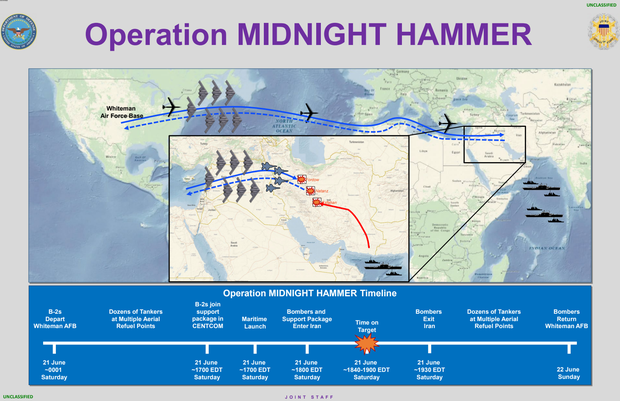Washington — Senior Pentagon officials revealed new details about the U.S. operation to bomb three nuclear sites in Iran, with the chairman of the Joint Chiefs of Staff saying it was the “largest B-2 operational strike in U.S. history” and inflicted “extremely severe damage and destruction” to the targets.
“This was a highly classified mission with very few people in Washington knowing the timing or nature of this plan,” Gen. Dan Caine, the chairman, said in a briefing at the Pentagon Sunday morning detailing the strikes against the Iranian nuclear sites at Fordo, Natanz and Isfahan.
Caine said the mission, dubbed Operation Midnight Hammer, included seven B-2 Spirit bombers that flew east from their base in MIssouri to Iran. The 18-hour flight required multiple in-flight refuelings, and the bombers met up with U.S. fighter jets and support aircraft once over land in the Middle East in a “complex, tightly timed maneuver,” Caine said.
Map shows Iran targets, Operation Midnight Hammer flight path
Caine spoke in front of a map showing the flight path of the aircraft, and the timeline of key events in the operation:
At about 5 p.m. ET Saturday, just before the aircraft entered Iranian airspace, a U.S. submarine launched more than two dozen Tomahawk cruise missiles against targets at the site in Isfahan. As the bombers approached their targets, the U.S. deployed “several deception tactics, including decoys,” and fighter jets cleared the airspace ahead of them, checking for enemy aircraft and surface-to-air missiles.
“We are currently unaware of any shots fired at the U.S. strike package on the way in,” Caine said.
At about 6:40 p.m. ET, or 2:10 a.m. in Iran, the lead B-2 dropped two “bunker-buster” bombs known as the GBU-57 Massive Ordnance Penetrators, or MOPs, on the site at Fordo. Over the next 25 minutes, Caine said, a total of 14 MOPs would be dropped on two target areas. The Tomahawk missiles landed at Isfahan after bombs were dropped on the two other sites. Caine said no shots were fired at the planes as they left Iranian airspace.
“Iran’s fighters did not fly, and it appears that Iran’s surface-to-air missile systems did not see us. Throughout the mission, we retained the element of surprise,” Caine said.
“More than 125 U.S. aircraft participated in this mission,” Caine said, including the B-2 bombers, fighter jets, refueling planes and surveillance aircraft. More than 75 precision-guided weapons were used in the attack.
“Initial battle damage assessments indicate that all three sites sustained extremely severe damage and destruction,” Caine said, noting that a full assessment will take time.
The chairman warned Iran against taking any retaliatory action for the strikes.
“Our forces remain on high alert and are fully postured to respond to any Iranian retaliation or proxy attacks, which would be an incredibly poor choice,” Caine said. “We will defend ourselves.”
Defense Secretary Pete Hegseth called the attack “an incredible and overwhelming success.”
“The order we received from our commander in chief was focused, it was powerful, and it was clear,” Hegseth said at the briefing alongside Caine. “We devastated the Iranian nuclear program, but it’s worth noting that the operation did not target Iranian troops or the Iranian people.”
He added: “The operation President Trump planned was bold, and it was brilliant, showing the world that American deterrence is back. When this president speaks, the world should listen.”
“Our B-2s went in and out … and back without the world knowing at all,” Hegseth said. “In that way it was historic. A strike that included the longest B-2 Spirit bomber mission since 2001, and the first operational employment of the MOP, a Massive Ordnance Penetrator.”
Mr. Trump announced Saturday evening that the U.S. had launched strikes against Iran. He said in a national address later Saturday night that the sites “have been completely and totally obliterated.”
Flanked by Hegseth, Secretary of State Marco Rubio and Vice President JD Vance at the White House, the president described the strikes as a “spectacular military success” and warned of “far greater” attacks if Iran does not “make peace.”
“If peace does not come quickly, we will go after those other targets with precision, speed and skill, most of them can be taken out in a matter of minutes,” he said. “There’s no military in the world that could have done what we did tonight, not even close. There has never been a military that could do what took place just a little while ago.”

